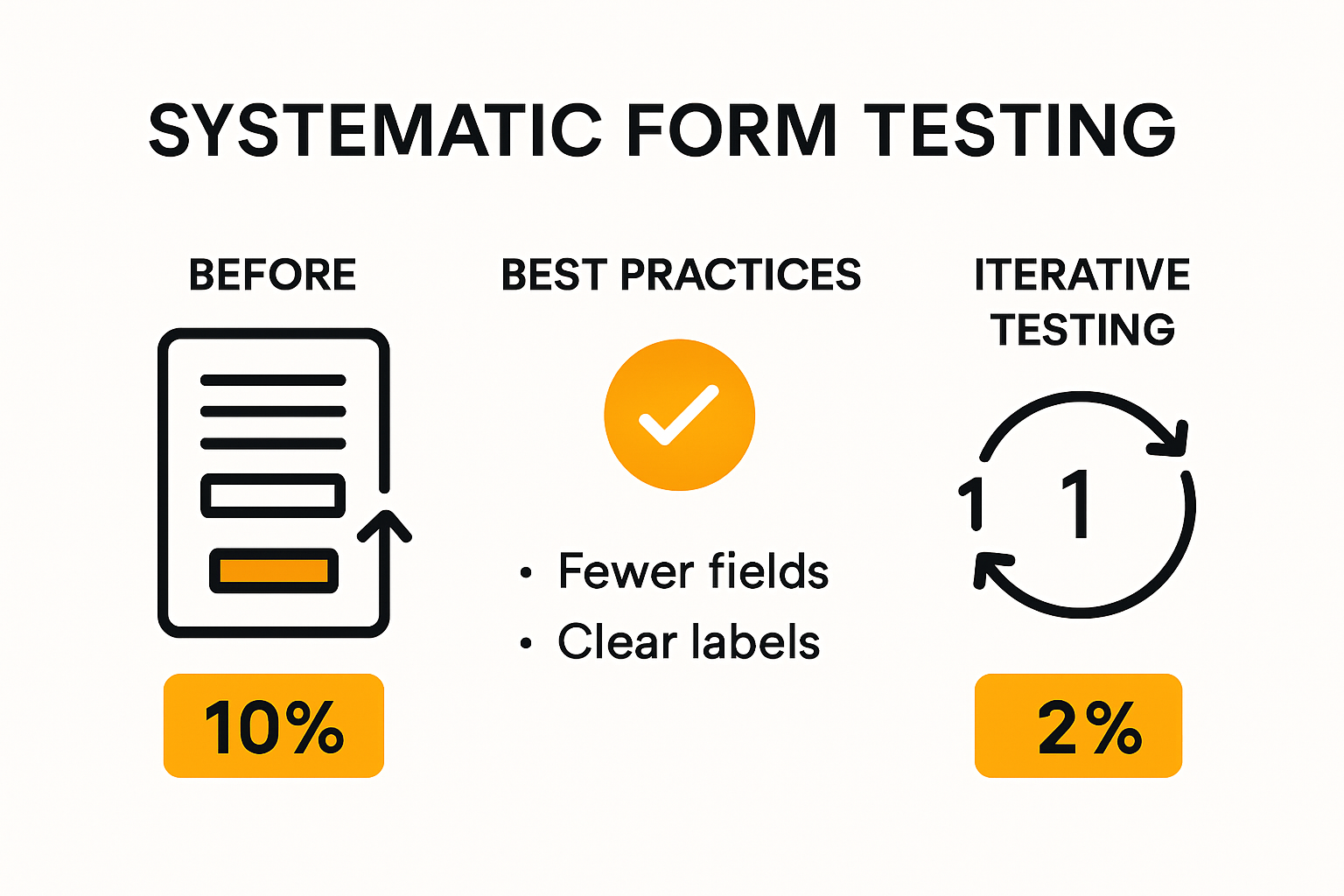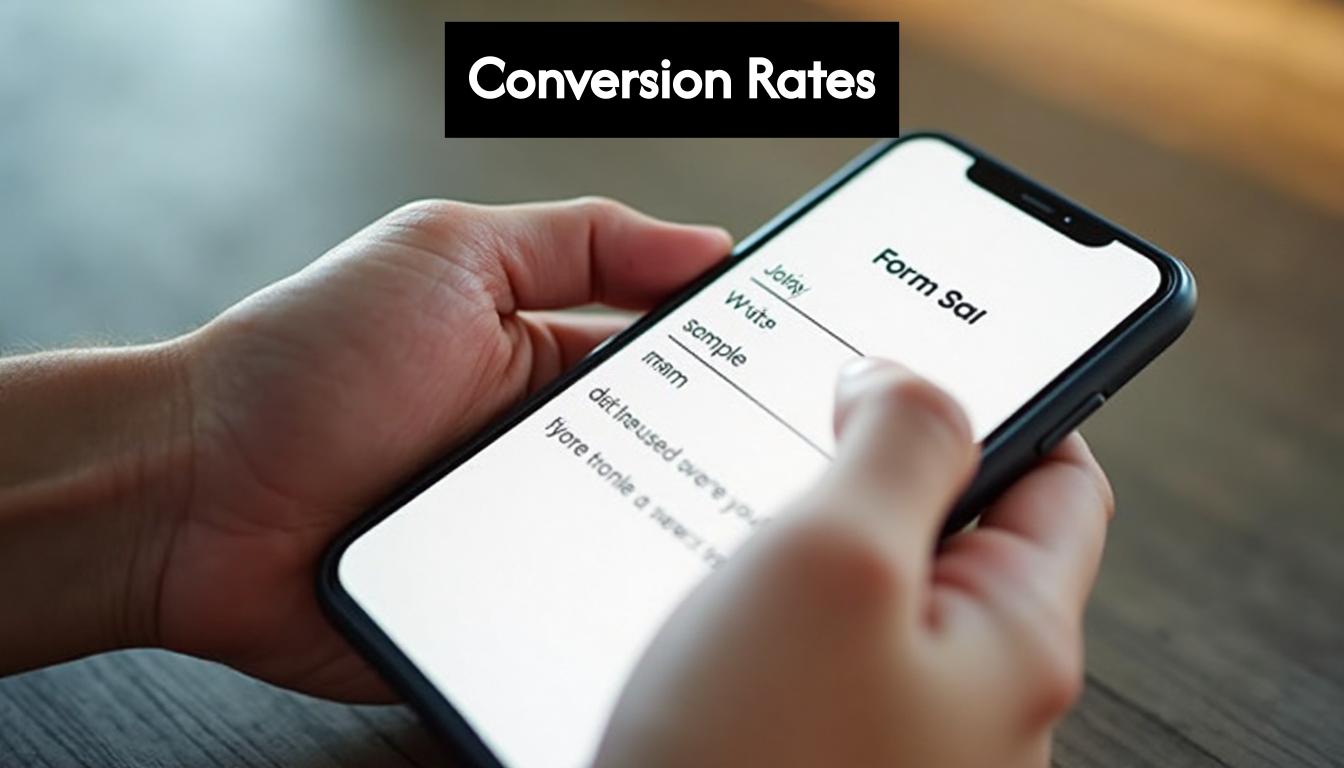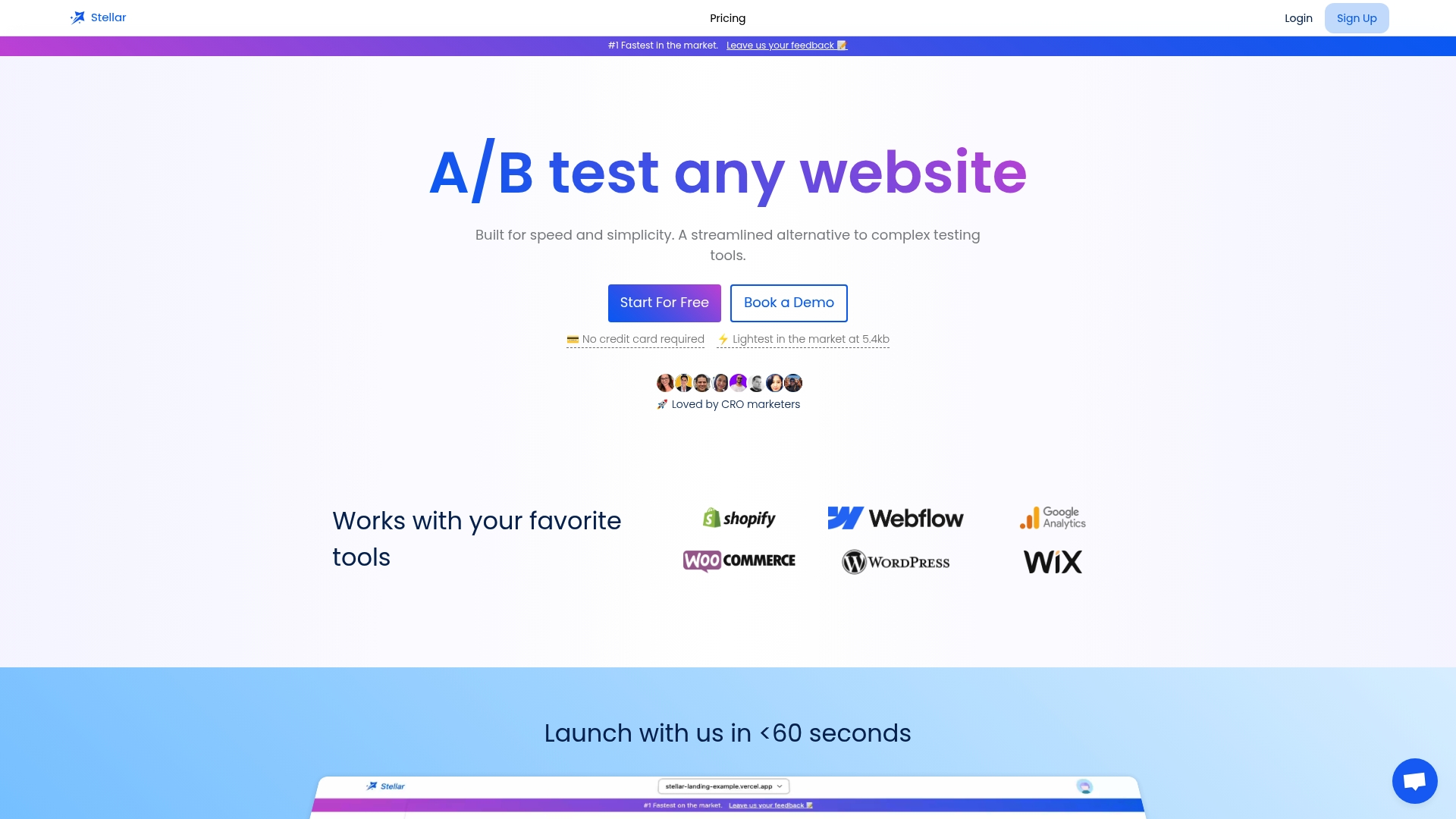
Form Testing Strategies for CRO and Growth Teams in 2025

Form testing is rewriting the rules for how marketers drive online conversions. Here is something you might not expect. Systematic form testing can lead to conversion rate increases of up to 30 percent. Most teams are still stuck tweaking colors or moving buttons around, while their smartest competitors treat forms as living assets tuned week after week. Instead of being just a box for user data, a well-tested form becomes a powerful lever for growth. Curious how this shift plays out next year? The real breakthroughs might surprise you.
Table of Contents
- Why Form Testing Matters For Modern Marketers
- Key Steps To Effective Form Testing Workflows
- Best Practices And Tools For Higher Conversion Rates
- Common Mistakes To Avoid In Form Optimization
Quick Summary
| Takeaway | Explanation |
|---|---|
| Form Testing Is Essential | Form testing goes beyond aesthetics; it is crucial for maximizing conversion rates and user engagement, with systematic testing showing potential conversion boosts of up to 30%. |
| Implement Iterative Testing | Establishing a cyclical approach to form testing enables continuous improvement through hypothesis generation, experimentation, and ongoing refinement. |
| Focus on User Experience | Reducing cognitive load and optimizing trust signals can significantly improve user interactions, as complicated forms can derail conversions. |
| Avoid Form Complexity | Keeping forms simple by minimizing fields and providing clear instructions is vital. Overcomplicating forms can create barriers to user engagement. |
| Prioritize Mobile Optimization | It’s critical to design responsive, touch-friendly forms for mobile devices to ensure a seamless user experience across various platforms. |
Why Form Testing Matters for Modern Marketers
In the rapidly evolving digital marketing ecosystem of 2025, form testing has become a critical strategy for growth teams seeking to maximize conversion rates and user engagement. Modern marketers recognize that forms are not just data collection tools but pivotal conversion points that can make or break the user experience.
The Conversion Impact of Strategic Form Optimization
Form testing goes far beyond simple aesthetic adjustments. According to research from Fermat Commerce, businesses that systematically test and iterate on their conversion funnels can see dramatic improvements in user acquisition and retention. Even minor modifications to form design, copy, or placement can yield significant conversion rate increases.
The data speaks volumes. The Frank Agency's research reveals that A/B testing landing pages and forms can potentially boost conversions by up to 30%. This statistic underscores why form testing is no longer optional but essential for competitive digital marketing strategies.

User Experience and Psychological Friction
At its core, form testing addresses user experience friction points. Modern users have increasingly high expectations for digital interactions. A complicated, lengthy, or confusing form can instantly derail potential conversions. By meticulously testing form elements, marketers can:
- Reduce Cognitive Load: Simplify form fields to minimize user overwhelm
- Increase Trust: Design forms that feel secure and professional
- Optimize User Flow: Create intuitive form experiences that guide users seamlessly
For those looking to dive deeper into optimization strategies, our comprehensive guide on A/B testing digital marketing techniques provides advanced insights into creating high-converting forms.
Successful form testing requires a strategic approach that combines data analysis, user psychology, and continuous experimentation. By treating forms as dynamic conversion tools rather than static elements, growth teams can unlock significant performance improvements and create more engaging user experiences.
Key Steps to Effective Form Testing Workflows
Creating a robust form testing workflow requires strategic planning, precise execution, and continuous refinement. Growth teams in 2025 must develop comprehensive approaches that go beyond traditional testing methodologies to ensure maximum conversion optimization.
Developing a Systematic Test Planning Framework
Successful form testing begins with meticulous planning. According to MuukTest's workflow guide, integrating quality assurance from the initial requirements phase is crucial for aligning testing objectives with broader business goals. This means creating a detailed test plan that outlines specific parameters such as testing scope, resource allocation, potential risk areas, and expected outcomes.
Key components of an effective test planning framework include:
- Comprehensive Scope Definition: Clearly map out all form elements to be tested
- Risk Assessment: Prioritize testing based on potential impact on user conversion
- Resource Allocation: Assign specific roles and responsibilities to team members
Implementing Iterative Testing Strategies
Iterative testing represents the cornerstone of modern form optimization. Testing best practices from BugBug emphasize the importance of developing a cyclical approach that allows for continuous improvement. This means moving beyond one-time assessments and creating a dynamic workflow that adapts to changing user behaviors and technological advancements.
The iterative process typically involves:
- Hypothesis generation
- Controlled experimentation
- Data collection and analysis
- Strategic implementation of insights
- Continuous monitoring and refinement
For marketers seeking to accelerate their testing capabilities, our insights on speed-focused testing tools can provide additional strategies for efficient workflow management.
Growth teams must recognize that form testing is not a static process but a dynamic, ongoing strategy. By implementing a structured workflow that prioritizes systematic planning, iterative testing, and continuous learning, organizations can transform their forms from mere data collection points into powerful conversion optimization tools.
Best Practices and Tools for Higher Conversion Rates

In the competitive digital landscape of 2025, optimizing form conversion rates requires a strategic blend of psychological insights, design principles, and advanced technological tools. Growth teams must move beyond traditional approaches to create forms that not only collect data but also provide seamless user experiences.
Psychological Design and User Experience Optimization
Form Assembly's research highlights the critical role of microcopy and psychological design in form conversion. Implementing strategic elements can dramatically reduce user friction and increase completion rates. These elements include:
- Trust Signals: Incorporating security badges, customer testimonials, and clear privacy statements
- Progressive Disclosure: Breaking complex forms into manageable, multi-step processes
- Contextual Microcopy: Adding helpful, reassuring text near form fields to reduce user anxiety
Advanced Conversion Rate Optimization Techniques
Everconnect's optimization guide emphasizes the importance of simplification. Modern form design focuses on reducing cognitive load by minimizing unnecessary fields and creating intuitive user flows. Successful teams leverage data-driven strategies to streamline form interactions.
For marketers seeking comprehensive optimization strategies, our in-depth guide on conversion rate optimization provides additional insights into cutting-edge techniques.
Continuous Testing and Tool Selection
RiiThink's conversion optimization research underscores the ongoing nature of form optimization. Successful growth teams implement continuous A/B testing across multiple form elements, including:
- Headline variations
- Call-to-action button designs
- Field placement and order
- Visual design elements
- Form length and complexity
Choosing the right conversion rate optimization tools that prioritize speed can significantly impact testing efficiency and overall form performance.
Ultimately, form conversion optimization is a nuanced art that combines psychological understanding, data-driven insights, and continuous experimentation. By approaching form design as a dynamic, user-centric process, growth teams can create experiences that not only collect information but also build trust and drive meaningful user engagement.
Common Mistakes to Avoid in Form Optimization
Form optimization requires a nuanced approach, and even experienced growth teams can fall into predictable traps that undermine conversion potential. Understanding and avoiding common pitfalls is crucial for creating high-performing forms that effectively capture user information while maintaining a positive user experience.
Overcomplicating Form Design and Structure
Everconnect's optimization research reveals that form complexity is a primary conversion killer. Many organizations inadvertently create barriers by requesting excessive or unnecessary information. The most critical mistake is treating forms as data collection tools rather than user-centric experiences.
Key complexity issues include:
- Excessive Field Quantity: Requesting more information than absolutely necessary
- Unclear Field Requirements: Failing to distinguish between optional and mandatory fields
- Complex Layout: Designing forms that feel overwhelming or visually cluttered
Input Validation and User Guidance Failures
Form Assembly's conversion optimization guide highlights the importance of clear user guidance and flexible input mechanisms. Common validation mistakes can transform a potentially smooth user interaction into a frustrating experience.
Potential validation pitfalls include:
- Rigid Input Formats: Enforcing strict input requirements without providing clear examples
- Inadequate Error Messaging: Using generic or unhelpful error notifications
- Lack of Real-Time Validation: Not providing immediate feedback on user inputs
For deeper insights into avoiding optimization errors, our comprehensive guide on conversion rate strategies offers additional advanced techniques.
Neglecting Mobile and Cross-Device Experience
In 2025, form optimization must transcend desktop-centric design. Failing to create responsive, mobile-friendly forms represents a significant strategic oversight. Users expect seamless experiences across multiple devices, and forms that do not adapt dynamically will inevitably lose potential conversions.
Critical mobile optimization considerations include:
- Touch-friendly input fields
- Appropriately sized buttons and interactive elements
- Simplified keyboard interactions
- Reduced cognitive load for smaller screens
Successful form optimization demands a holistic approach that prioritizes user experience, minimizes friction, and creates intuitive pathways for information collection. By systematically addressing these common mistakes, growth teams can transform forms from potential conversion barriers into strategic assets that drive meaningful user engagement.
Frequently Asked Questions
What is form testing in marketing?
Form testing is the systematic evaluation of online forms to optimize them for higher conversion rates, enhancing user experience and reducing friction points during data collection.
How can systematic form testing improve conversion rates?
Systematic form testing can lead to conversion rate increases of up to 30% by optimizing design, copy, and user flow through iterative testing and data analysis.
What are common mistakes to avoid in form optimization?
Common mistakes include overcomplicating form design with excessive fields, failing to provide clear user guidance, and neglecting mobile optimization for responsive design.
Why is user experience important for form testing?
User experience is crucial in form testing as a straightforward, intuitive form reduces cognitive load and builds trust, thereby increasing the likelihood of users completing the form.
Ready to Turn Form Frustration into Fast Growth?
Stuck watching high drop-off rates on your forms, even after multiple tweaks? If the friction and complexity discussed in your conversion workflows sound familiar, it's time for a faster path to real progress. Your growth team deserves a tool that evolves with your users and makes systematic testing simple. With Stellar, you get instant access to a lightweight, no-code A/B testing solution designed to transform forms into high-performing assets. Track every change in real time, personalize instantly, and experiment without the tech overhead. Unlock actionable insights that erase guesswork and drive the kind of 30% conversion increases this article highlights.

Why wait, hoping your next manual test will work? Start a free trial with Stellar now and experience effortless form optimization. Discover how intuitive testing, advanced goal tracking, and real-time analytics can help you finally move the needle. Join marketers already streamlining their CRO for 2025. Take the next step today at Stellar.
Recommended Articles
Published: 6/19/2025
